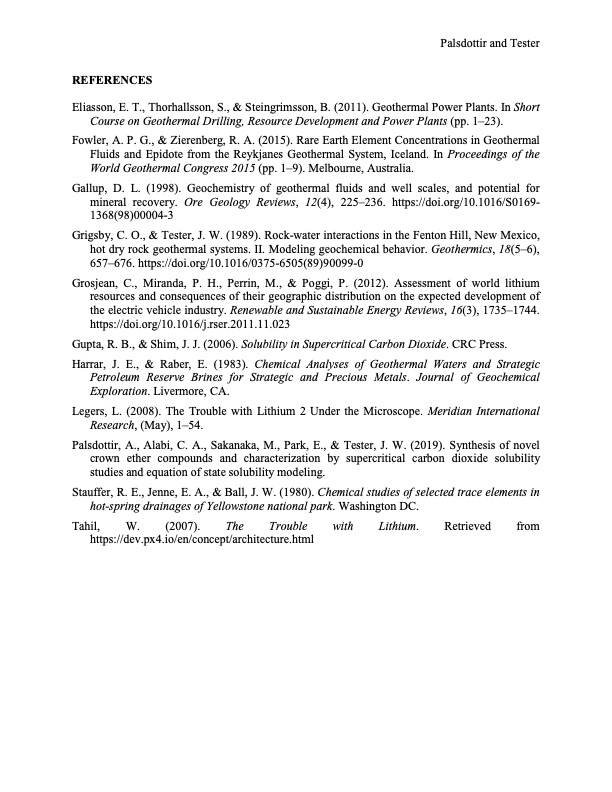
PDF Publication Title:
Text from PDF Page: 008
REFERENCES Eliasson, E. T., Thorhallsson, S., & Steingrimsson, B. (2011). Geothermal Power Plants. In Short Course on Geothermal Drilling, Resource Development and Power Plants (pp. 1–23). Fowler, A. P. G., & Zierenberg, R. A. (2015). Rare Earth Element Concentrations in Geothermal Fluids and Epidote from the Reykjanes Geothermal System, Iceland. In Proceedings of the World Geothermal Congress 2015 (pp. 1–9). Melbourne, Australia. Gallup, D. L. (1998). Geochemistry of geothermal fluids and well scales, and potential for mineral recovery. Ore Geology Reviews, 12(4), 225–236. https://doi.org/10.1016/S0169- 1368(98)00004-3 Grigsby, C. O., & Tester, J. W. (1989). Rock-water interactions in the Fenton Hill, New Mexico, hot dry rock geothermal systems. II. Modeling geochemical behavior. Geothermics, 18(5–6), 657–676. https://doi.org/10.1016/0375-6505(89)90099-0 Grosjean, C., Miranda, P. H., Perrin, M., & Poggi, P. (2012). Assessment of world lithium resources and consequences of their geographic distribution on the expected development of the electric vehicle industry. Renewable and Sustainable Energy Reviews, 16(3), 1735–1744. https://doi.org/10.1016/j.rser.2011.11.023 Gupta, R. B., & Shim, J. J. (2006). Solubility in Supercritical Carbon Dioxide. CRC Press. Harrar, J. E., & Raber, E. (1983). Chemical Analyses of Geothermal Waters and Strategic Petroleum Reserve Brines for Strategic and Precious Metals. Journal of Geochemical Exploration. Livermore, CA. Legers, L. (2008). The Trouble with Lithium 2 Under the Microscope. Meridian International Research, (May), 1–54. Palsdottir, A., Alabi, C. A., Sakanaka, M., Park, E., & Tester, J. W. (2019). Synthesis of novel crown ether compounds and characterization by supercritical carbon dioxide solubility studies and equation of state solubility modeling. Stauffer, R. E., Jenne, E. A., & Ball, J. W. (1980). Chemical studies of selected trace elements in hot-spring drainages of Yellowstone national park. Washington DC. Tahil, W. (2007). The Trouble with Lithium. Retrieved from https://dev.px4.io/en/concept/architecture.html Palsdottir and TesterPDF Image | Mining the Future Lithium

PDF Search Title:
Mining the Future LithiumOriginal File Name Searched:
1034174.pdfDIY PDF Search: Google It | Yahoo | Bing
Product and Development Focus for Infinity Turbine
ORC Waste Heat Turbine and ORC System Build Plans: All turbine plans are $10,000 each. This allows you to build a system and then consider licensing for production after you have completed and tested a unit.Redox Flow Battery Technology: With the advent of the new USA tax credits for producing and selling batteries ($35/kW) we are focussing on a simple flow battery using shipping containers as the modular electrolyte storage units with tax credits up to $140,000 per system. Our main focus is on the salt battery. This battery can be used for both thermal and electrical storage applications. We call it the Cogeneration Battery or Cogen Battery. One project is converting salt (brine) based water conditioners to simultaneously produce power. In addition, there are many opportunities to extract Lithium from brine (salt lakes, groundwater, and producer water).Salt water or brine are huge sources for lithium. Most of the worlds lithium is acquired from a brine source. It's even in seawater in a low concentration. Brine is also a byproduct of huge powerplants, which can now use that as an electrolyte and a huge flow battery (which allows storage at the source).We welcome any business and equipment inquiries, as well as licensing our turbines for manufacturing.| CONTACT TEL: 608-238-6001 Email: greg@infinityturbine.com | RSS | AMP |